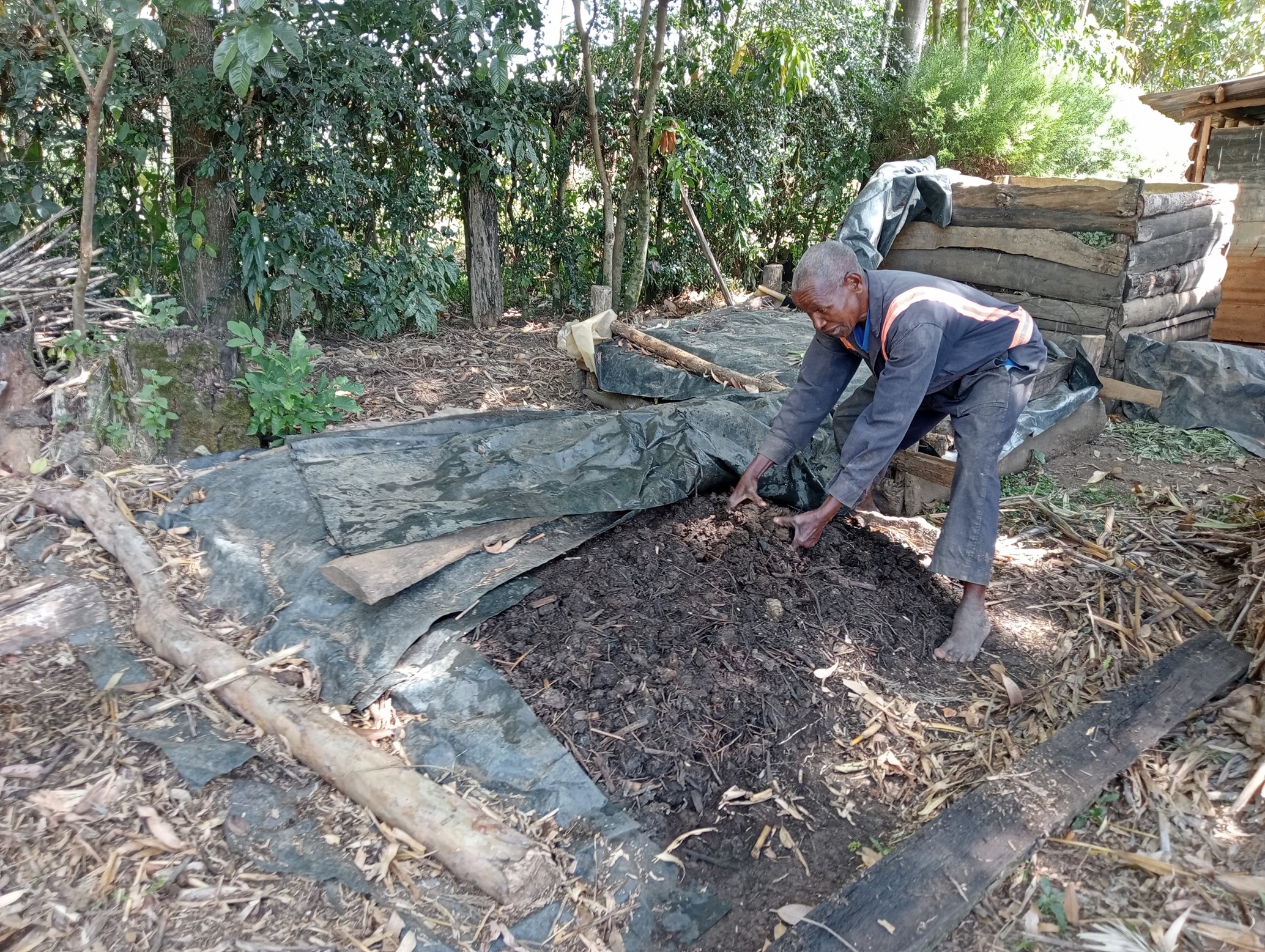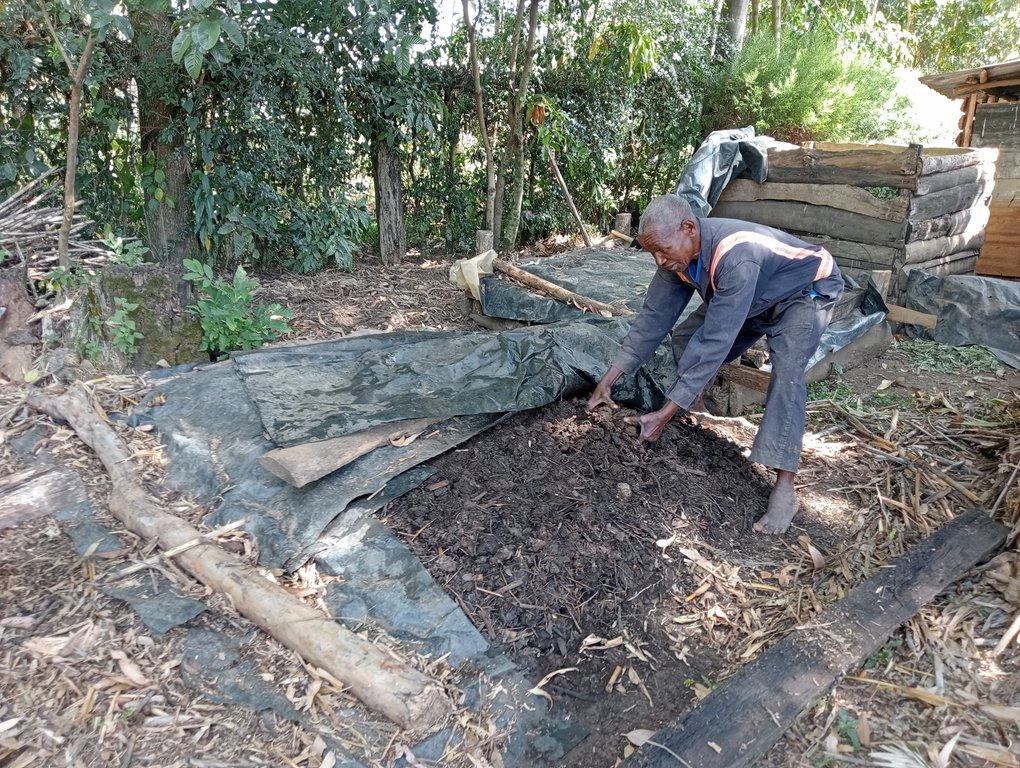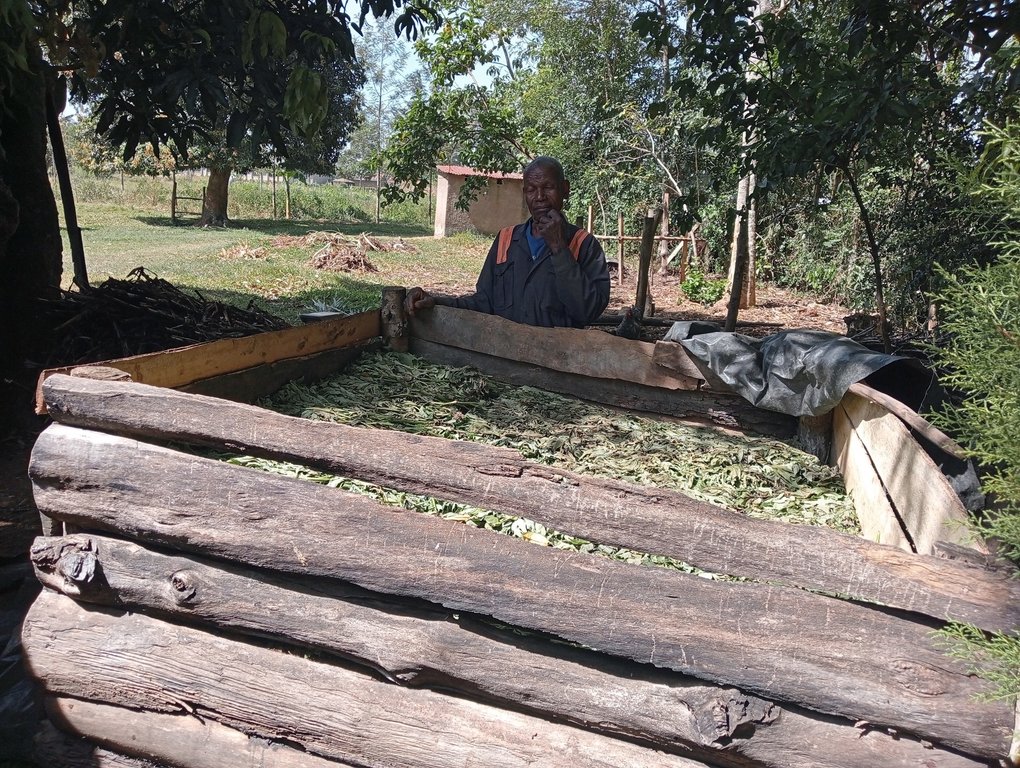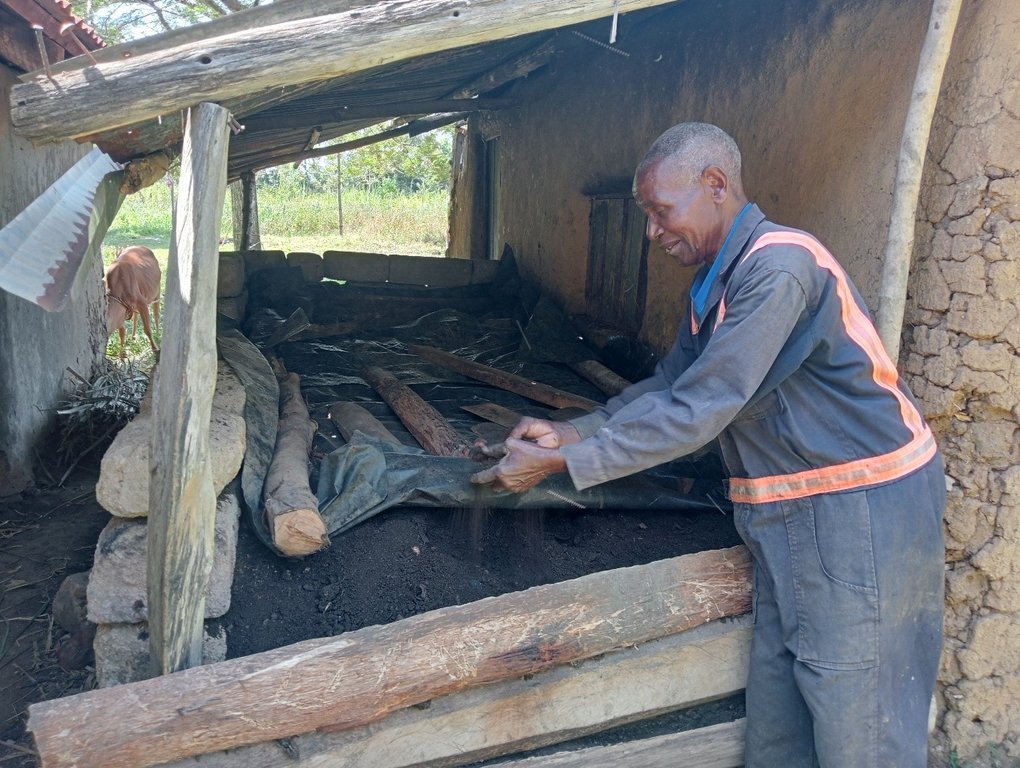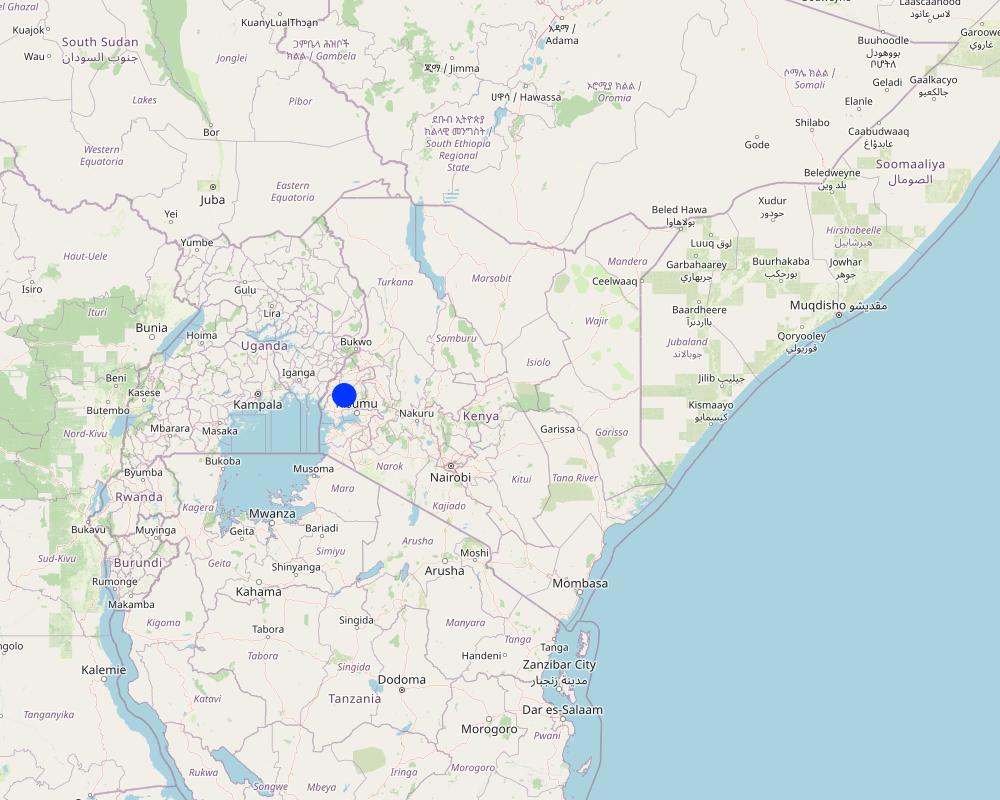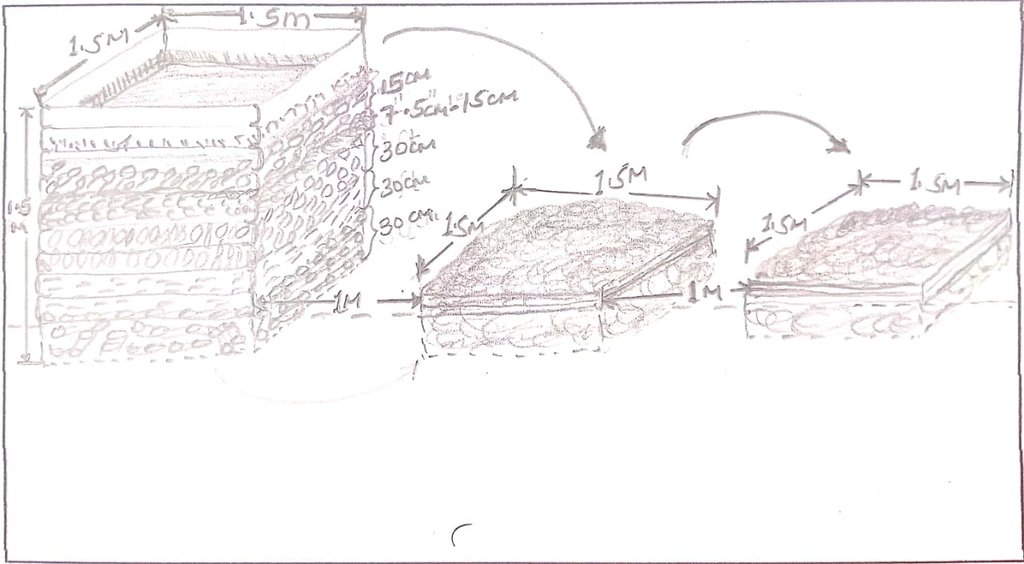Compost for organic waste management and improved crop yields [肯尼亚]
- 创建:
- 更新:
- 编制者: William Akwanyi
- 编辑者: George Onyango, Innocent Faith, Noel Templer, Tabitha Nekesa, Ahmadou Gaye, Siagbé Golli
- 审查者: William Critchley, Rima Mekdaschi Studer, Sally Bunning
Mbolea bora (Kiswahili)
technologies_6648 - 肯尼亚
查看章节
全部展开 全部收起1. 一般信息
1.2 参与该技术评估和文件编制的资源人员和机构的联系方式
关键资源人
土地使用者:
Anyanga Matthews George
Welthungerhilfe
肯尼亚
SLM专业人员:
SLM专业人员:
有助于对技术进行记录/评估的项目名称(如相关)
Soil protection and rehabilitation for food security (ProSo(i)l)有助于对技术进行记录/评估的机构名称(如相关)
Deutsche Gesellschaft für Internationale Zusammenarbeit (GIZ)有助于对技术进行记录/评估的机构名称(如相关)
CIAT International Center for Tropical Agriculture (CIAT International Center for Tropical Agriculture) - 肯尼亚1.3 关于使用通过WOCAT记录的数据的条件
编制者和关键资源人员接受有关使用通过WOCAT记录数据的条件。:
是
1.4 所述技术的可持续性声明
这里所描述的技术在土地退化方面是否存在问题,导致无法被认为是一种可持续的土地管理技术?:
否
注释:
Farmers who have implemented the technology have recorded good harvests from their farms. The product of manure has improved their soils.
1.5 参考关于SLM方法(使用WOCAT记录的SLM方法)的调查问卷
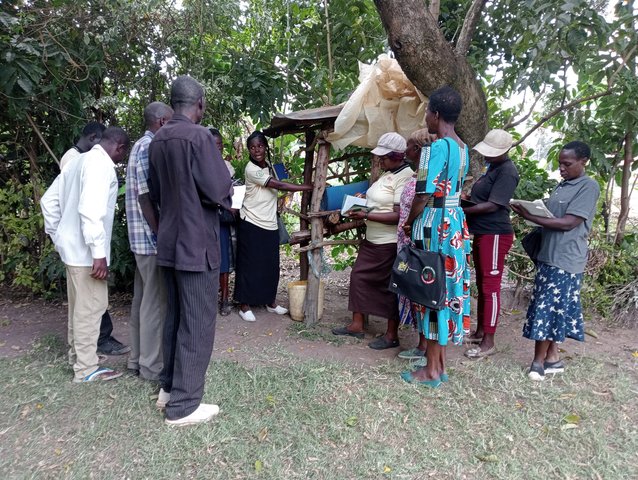
Community Resource Persons (CRP) in agricultural extension [肯尼亚]
Community Resource Persons (CRP) form a farmer-to-farmer learning approach that bridges the gap in agricultural extension, increases farmers' access to agricultural information (SLM knowledge), and increases the adoption of SLM practices.
- 编制者: William Akwanyi
2. SLM技术的说明
2.1 技术简介
技术定义:
Composting with on-farm organic solid waste management improves the soil sustainably and raises crop yields.
2.2 技术的详细说明
说明:
Composting is a natural process of converting organic materials such as plant leaves, and food remains into a nutrient-rich soil-enhancing amendment called compost (if mainly from vegetative matter) or manure (if mainly from animal dung). It involves breaking organic matter down into humus/ compost by aerobic microorganisms - with by-products of water, heat, ammonia (NH3), and carbon dioxide (CO2). Humus is a dark and crumbly natural form of fertilizer applied to the soil to improve crop production. Composting is cost-effective since it can be made from locally available materials such as leaves, plant residues, food remains, cow dung, poultry droppings, animal urine, soil, etc. Composting is thus an on-farm solid waste management measure. When made correctly it can improve carbon sequestration in the soil (compost is carbon-rich) and prevent methane emissions (a greenhouse gas) since methane-producing microbes become inactive in aerobic conditions (in the presence of oxygen).
There are many ways of preparing compost. This method involves three key stages; mixing brown organic materials, such as twigs, and green materials, such as fresh leaves that are nitrogen-rich and moist. In the first stage, brown and green materials are layered, beginning with a 30 cm layer of twigs at the bottom, followed by a 30 cm layer of dry matter, such as maize straw chopped to a maximum of 7.5 cm. This is followed by a 30 cm layer of dry grass and dry leaves covered by a 7.5 cm – 15 cm layer of fresh cow dung. The fresh cow dung is covered by a 15 cm layer of fresh tithonia (an exotic plant) that is completely covered by a layer of ash and sprayed uniformly using 10 litres of animal urine and finally completely covered by a layer of soil or manure. All the above inputs except urine are sprayed with 10 – 20 litres of water. The pile is then completely covered with a black polythene sheet to help absorb heat, prevent the entry of rainwater, and prevent volatilization of nitrogen, i.e., the conversion of ammonium into ammonia gas, and left to decompose for 21 to 30 days.
The second stage involves mixing and transferring all the material except the twigs, to another space. The heap is again completely covered with a black polythene sheet to help absorb heat, prevent rainwater entry, and prevent nitrogen volatilization. It is again left to decompose for another 21 to 30 days. The third stage, like the second stage, involves completely mixing and transferring all the material from the second stage to another space and completely covering the heap with a black polythene sheet to help absorb heat and prevent the entry of rainwater. The contents are allowed to decompose for another 21 to 30 days, after which they are ready-to-use compost. The compost is stored under shade and covered with a black polythene sheet again to prevent nitrogen volatilization.
One heap of compost (first stage: 1.5 m by 1.5 m by 1.5 m) produces about 5 tonnes of ready-to-use compost. Composting takes about 90 days; hence, provided that all inputs are available, a farmer can produce compost 4 times each year from the same heaping point, i.e., about 20 tonnes. Normally, a 0.4-hectare farm requires about 20 tonnes of this compost. However, the amount varies from farm to farm depending on the conditions of the soil and the crop(s) to be grown. It is important that soil testing is done to determine the conditions of the soil to ensure that the compost is being used in the most effective manner.
Compost is carried to the farm on wheelbarrows and in buckets and is applied at the farm during planting time where a handful of compost is applied in the planting hole and mixed with soil before planting. It is again applied around the base of the crop and completely covered with soil. Preparation of compost in conservation agriculture situations could pose the problem of competition for plant material since plant material is used in conservation agriculture to cover the soil. To manage this, a farmer implementing both composting and conservation agriculture may have to acquire plant material for composting from other sources such as purchasing stover from other farmer who are not implementing conservation agriculture. In addition, the farmer could also use hedge trimmings as plant material for composting, especially if the farmer has a live fence.
2.3 技术照片
关于照片的一般说明:
Composting is a multi-stage process. The inputs/ materials in each stage must be completely covered with a black polythene sheet to help absorb heat, prevent the entry of rainwater, and prevent volatilization of nitrogen. The materials are allowed to decompose for at least 21 days in each stage before they are completely mixed and transferred to the next.
2.5 已应用该技术的、本评估所涵盖的国家/地区/地点
国家:
肯尼亚
区域/州/省:
Kakamega County in western Kenya
有关地点的进一步说明:
Elang'ata Village, Bulanda Sub-location, Imanga Location, Marama Central Ward, Butere Sub-county
具体说明该技术的分布:
- 适用于特定场所/集中在较小区域
技术现场是否位于永久保护区?:
否
注释:
The farm where the technology is implemented is not in a protected area.
Map
×2.6 实施日期
注明实施年份:
2018
2.7 技术介绍
详细说明该技术是如何引入的:
- 通过土地使用者的创新
- 作为传统系统的一部分(> 50 年)
- 通过项目/外部干预
注释(项目类型等):
For years, the farmer has been converting farm wastes into manure. However, the Soil Protection and Rehabilitation of Degraded Soil for Food Security (ProSoil) project came in and taught them an improved method of composting that takes a shorter time compared with the traditional method, and prevents loss of nutrients during composting.
3. SLM技术的分类
3.1 该技术的主要目的
- 改良生产
- 减少、预防、恢复土地退化
- 适应气候变化/极端天气及其影响
- 减缓气候变化及其影响
- 创造有益的经济影响
3.2 应用该技术的当前土地利用类型
同一土地单元内混合使用的土地::
是
具体说明混合土地使用(作物/放牧/树木):
- 农林牧业

农田
- 一年一作
- 多年一作(非木材)
- 乔木与灌木的种植
年作 - 具体指明作物:
- 饲料作物 - 草
- 谷物类 - 玉米
- 蔬菜 - 其他
- 豆科牧草和豆类 - 豆子
- 根/块茎作物 - 木薯
年作制度:
玉米/高粱/谷子与豆类间作
多年生(非木质)作物 - 指定作物:
- 香蕉/芭蕉/蕉麻
乔木和灌木种植 - 指定作物:
- 鳄梨
- 水果、其他
- 芒果、山竹果、番石榴
- 木瓜
每年的生长季节数:
- 2
具体说明:
Long and short rain seasons
采用间作制度了吗?:
是
如果是,说明哪些作物是间作的:
Maize and beans
采用轮作制度了吗?:
是
如果是,请具体说明:
Some sections of the farm are left fallow during the short rains to allow for soil regeneration.

牧场
集约放牧/饲料生产:
- 收割和携带/零放牧
- 改良牧场
动物类型:
- 牛 - 奶制品
- cattle - dairy and beef (e.g. zebu)
- 家禽
是否实行作物与牲畜的综合管理?:
是
如果是,请具体说明:
Cattle dung and poultry droppings are used as inputs in composting. Compost is applied on soil where livestock fodder is planted.
产品和服务:
- economic security, investment prestige
- 奶类
- manure as fertilizer/ energy production
- 蛋类
- 肉类
品种:
牛 - 奶制品
计数:
2
品种:
cattle - dairy and beef (e.g. zebu)
计数:
3
品种:
家禽
计数:
10
注释:
There are assorted trees on the farm, and these provide litter which is an input in composting.
3.3 由于技术的实施,土地使用是否发生了变化?
由于技术的实施,土地使用是否发生了变化?:
- 否(继续问题3.4)
3.4 供水
该技术所应用土地的供水:
- 雨养
注释:
Crops are planted only during the rainy seasons since there is no irrigation.
3.5 该技术所属的SLM组
- 农畜综合管理
- 土壤肥力综合管理
- 废物管理/废水管理
3.6 包含该技术的可持续土地管理措施

农艺措施
- A2:有机质/土壤肥力
- A6:残株管理
A6:对残株管理作出具体说明:
A 6.3:收集
注释:
Plant residues, especially leaves and soft branches are collected and used as input in composting. However, some plant matter is retained in the farm to naturally decompose and turn into manure at the farm. The farmer does not collect plant residues from protected areas. He has planted tithonia at some sections of the hedges at his farm; this provides the main source of tithonia. However, he sometimes harvests tithonia from his neighbours' hedges upon request.
3.7 该技术强调的主要土地退化类型

化学性土壤退化
- Cn:肥力下降和有机质含量下降(非侵蚀所致)
- Ca:酸化
- Cp:土壤污染
注释:
Covering of compost-making materials and the final compost reduces loss of nitrogen through volatilization of ammonium into ammonia gas. Compost raises the pH of soils when applied at the farm. Compost contains living organisms (bacteria and fungi) that degrade soil pollutants into non-toxic substances.
3.8 防止、减少或恢复土地退化
具体数量名该技术与土地退化有关的目标:
- 防止土地退化
- 修复/恢复严重退化的土地
注释:
Compost improves soil structure and porosity. Compost balances soil pH.
4. 技术规范、实施活动、投入和成本
4.1 该技术的技术图纸
技术规范(与技术图纸相关):
Stage 1: about 30 cm deep under the ground, 1.5 m long by 1.5 m wide by 1.5 m high, including the 30 cm below the ground. Constructed using timber off-cuts (locally known as magogo) supported on posts at corners using nails. From bottom: 30 cm of twigs to extend some few inches above the ground to allow air circulation, 30 cm of dry matter e.g., maize straw chopped to 7.5 cm maximum, 30 cm dry grass and leaves, 7.5 cm - 15 cm layer of fresh cow dung, 15 cm layer of fresh tithonia, layer of ash, layer of soil or manure, black polythene sheet cover.
Stages 2 and 3: about 1-ft deep under the ground, 1.5 m long by 1.5 m wide, height depends on the volume of the material.
Allow space of no more than 1 m from one stage to the other for easy of mixing and transfer of materials from one stage to the next.
作者:
William Onura
日期:
26/01/2023
4.2 有关投入和成本计算的一般信息
具体说明成本和投入是如何计算的:
- 每个技术单元
指定单位:
Heap of compost
指定单位面积(如相关):
1.5 m by 1.5 m by 1.5 m
其它/国家货币(具体说明):
KES
如相关,注明美元与当地货币的汇率(例如1美元=79.9巴西雷亚尔):1美元=:
122.95
注明雇用劳工的每日平均工资成本:
200
4.3 技术建立活动
| 活动 | 时间(季度) | |
|---|---|---|
| 1. | Digging of pits | At least 3 months before planting time |
| 2. | Framework construction with off cuts | At least 3 months before planting time |
| 3. | Filling stage one with inputs | At least 3 months before planting time |
注释:
Composting takes about 3 months; hence, the farmer should have the structures for composting at least 3 months before the planting time. A farmer can produce 20 tonnes of compost from 1 heap (1.5 m by 1.5 m by 1.5 m).
4.4 技术建立所需要的费用和投入
| 对投入进行具体说明 | 单位 | 数量 | 单位成本 | 每项投入的总成本 | 土地使用者承担的成本% | |
|---|---|---|---|---|---|---|
| 劳动力 | Framework construction | Man-days | 2.0 | 200.0 | 400.0 | 100.0 |
| 劳动力 | Filling inputs | Man-days | 1.0 | 200.0 | 200.0 | 100.0 |
| 设备 | Jembe (hoe) | No. | 1.0 | 80.0 | 80.0 | |
| 设备 | Spade | No. | 1.0 | 90.0 | 90.0 | |
| 设备 | Fork hoe | No. | 1.0 | 70.0 | 70.0 | |
| 设备 | Wheelbarrow | No. | 1.0 | 800.0 | 800.0 | |
| 设备 | Hummer | No. | 1.0 | 100.0 | 100.0 | 100.0 |
| 设备 | Handsaw | No. | 1.0 | 200.0 | 200.0 | 100.0 |
| 植物材料 | Twigs | Wheelbarrow | 2.0 | 100.0 | 200.0 | 100.0 |
| 植物材料 | Dry matter | Wheelbarrow | 6.0 | 50.0 | 300.0 | 100.0 |
| 植物材料 | Dry grass and leaves | 90 Kg sack | 3.0 | 50.0 | 150.0 | 100.0 |
| 植物材料 | Fresh tithonia | 90 Kg sack | 3.0 | 50.0 | 150.0 | 100.0 |
| 肥料和杀菌剂 | Ash | 90 Kg sack | 0.4 | 200.0 | 80.0 | 100.0 |
| 肥料和杀菌剂 | Animal urine | 10 litre container | 1.0 | 125.0 | 125.0 | 100.0 |
| 肥料和杀菌剂 | Soil or manure | Wheelbarrow | 1.0 | 300.0 | 300.0 | 100.0 |
| 肥料和杀菌剂 | Fresh cow dung | Wheelbarrow | 3.0 | 200.0 | 600.0 | 100.0 |
| 施工材料 | Timber off-cuts | Pieces | 16.0 | 100.0 | 1600.0 | 100.0 |
| 施工材料 | Wooden posts | Pieces | 4.0 | 50.0 | 200.0 | 100.0 |
| 施工材料 | Nails (assorted sizes) | Kgs | 3.0 | 200.0 | 600.0 | 100.0 |
| 其它 | Water | 20 litres container | 4.0 | 5.0 | 20.0 | 100.0 |
| 技术建立所需总成本 | 6265.0 | |||||
| 技术建立总成本,美元 | 50.96 | |||||
如果土地使用者负担的费用少于100%,请注明由谁负担其余费用:
ProSoil project
注释:
The ProSoil project through Welthungerhilfe provided hoes, fork hoes, wheelbarrows, and spades to the farmers. The costs of these implements are KES 400/- for a hoe, KES 350/- for a fork hoe, KES 4,000/- for a wheelbarrow, KES 450/- for a spade, KES 500/- for a hummer, and KES 1,000/- for a handsaw. It is assumed that the farmer will be able to use the hoe, fork hoe, spade, hummer, and handsaw over a period of 5 years, and a wheelbarrow over a period of 10 years before these implements will have depreciated to a point where they will not be useable. The cost is thus spread over the years when the farmer will be able to use the implement.
4.5 维护/经常性活动
| 活动 | 时间/频率 | |
|---|---|---|
| 1. | Turning at each stage | 21 - 30 days after start of each stage |
| 2. | Refilling at the first stage | At turning from the first stage |
| 3. | Distribution to the farm | When planting and at first weeding (i.e., 3rd week after planting) |
注释:
Turning involves complete mixing and transfer of the inputs from one stage to the next. Compost is applied at the farm during planting time where a handful of compost is applied in the planting hole and mixed with soil before planting. It is again applied around the base of the crop and completely covered with soil.
4.6 维护/经常性活动所需要的费用和投入(每年)
| 对投入进行具体说明 | 单位 | 数量 | 单位成本 | 每项投入的总成本 | 土地使用者承担的成本% | |
|---|---|---|---|---|---|---|
| 劳动力 | Complete mixing and turning from stage one to stage two and from stage two to stage three | Man-days | 4.0 | 200.0 | 800.0 | 100.0 |
| 劳动力 | Refilling with new materials at the first stage | Man-days | 1.0 | 200.0 | 200.0 | 100.0 |
| 劳动力 | Transfer to storage | Man-days | 2.0 | 200.0 | 400.0 | 100.0 |
| 劳动力 | Distribution to the farm | Man-days | 2.0 | 200.0 | 400.0 | 100.0 |
| 设备 | Hoe | No. | 1.0 | 80.0 | 80.0 | |
| 设备 | Fork hoe | No. | 1.0 | 90.0 | 90.0 | |
| 设备 | Spade | No. | 1.0 | 70.0 | 70.0 | |
| 设备 | Wheelbarrow | No. | 1.0 | 400.0 | 400.0 | |
| 植物材料 | Dry matter | Wheelbarrow | 6.0 | 50.0 | 300.0 | 100.0 |
| 植物材料 | Dry grass and leaves | 90Kg sack | 3.0 | 50.0 | 150.0 | 100.0 |
| 植物材料 | Fresh tithonia | 90Kg sack | 3.0 | 50.0 | 150.0 | 100.0 |
| 肥料和杀菌剂 | Ash | 90 Kg sack | 0.4 | 200.0 | 80.0 | 100.0 |
| 肥料和杀菌剂 | Animal urine | 10 litre container | 1.0 | 125.0 | 125.0 | 100.0 |
| 肥料和杀菌剂 | Soil or manure | Wheelbarrow | 1.0 | 300.0 | 300.0 | 100.0 |
| 肥料和杀菌剂 | Fresh cowdung | Wheelbarrow | 3.0 | 200.0 | 600.0 | 100.0 |
| 其它 | Water | 20 litres container | 4.0 | 5.0 | 20.0 | 100.0 |
| 技术维护所需总成本 | 4165.0 | |||||
| 技术维护总成本,美元 | 33.88 | |||||
如果土地使用者负担的费用少于100%,请注明由谁负担其余费用:
ProSoil project
注释:
The hoes, fork hoes, wheelbarrows, and spades provided by the ProSoil project through Welthungerhilfe are fixed assets and are used for years by the farmer before they can wear out. The farmer can use these implements for other work at the farm. The costs of these implements are KES 400/- for a hoe, KES 350/- for a fork hoe, KES 4,000/- for a wheelbarrow, and KES 450/- for a spade. It is assumed that the farmer will be able to use the hoe, fork hoe, and spade over a period of 5 years, and a wheelbarrow over a period of 10 years before these implements will have depreciated to a point where they will not be useable. The cost is thus spread over the years when the farmer will be able to use the implement. The twigs are reused during the refilling process since they take long to decompose.
4.7 影响成本的最重要因素
描述影响成本的最决定性因素:
Rate of man-days vary from one place to another. It is not easy to attach monetary value to some of the input e.g., animal urine, cow dung, and water.
Exchange rate for January 2023, source: European Commission/ InfoEuro online at https://commission.europa.eu/funding-tenders/procedures-guidelines-tenders/information-contractors-and-beneficiaries/exchange-rate-inforeuro_en
5. 自然和人文环境
5.1 气候
年降雨量
- < 250毫米
- 251-500毫米
- 501-750毫米
- 751-1,000毫米
- 1,001-1,500毫米
- 1,501-2,000毫米
- 2,001-3,000毫米
- 3,001-4,000毫米
- > 4,000毫米
有关降雨的规范/注释:
Monthly rainfall variability is high with some months such as January recording less than 5 mm of total rainfall.
注明所考虑的参考气象站名称:
Kakamega Meteorological Station
农业气候带
- 潮湿的
The climate in the area favours most agricultural activities.
5.2 地形
平均坡度:
- 水平(0-2%)
- 缓降(3-5%)
- 平缓(6-10%)
- 滚坡(11-15%)
- 崎岖(16-30%)
- 陡峭(31-60%)
- 非常陡峭(>60%)
地形:
- 高原/平原
- 山脊
- 山坡
- 山地斜坡
- 麓坡
- 谷底
垂直分布带:
- 0-100 m a.s.l.
- 101-500 m a.s.l.
- 501-1,000 m a.s.l.
- 1,001-1,500 m a.s.l.
- 1,501-2,000 m a.s.l.
- 2,001-2,500 m a.s.l.
- 2,501-3,000 m a.s.l.
- 3,001-4,000 m a.s.l.
- > 4,000 m a.s.l.
说明该技术是否专门应用于:
- 不相关
关于地形的注释和进一步规范:
The farm is located at an area that is higher in altitude compared to other areas in the larger area. The average altitude for the area is 1,350m above sea level but the farm is at 1,401m above sea level.
5.3 土壤
平均土层深度:
- 非常浅(0-20厘米)
- 浅(21-50厘米)
- 中等深度(51-80厘米)
- 深(81-120厘米)
- 非常深(> 120厘米)
土壤质地(表土):
- 中粒(壤土、粉土)
土壤质地(地表以下> 20厘米):
- 粗粒/轻(砂质)
表土有机质:
- 中(1-3%)
如有可能,附上完整的土壤描述或具体说明可用的信息,例如土壤类型、土壤酸碱度、阳离子交换能力、氮、盐度等。:
Soil pH of most farms in the area ranges from moderately acid (5.50) to moderately alkaline (7.80).
5.4 水资源可用性和质量
地下水位表:
5-50米
地表水的可用性:
好
水质(未处理):
不良饮用水(需要处理)
水质请参考::
地下水和地表水
水的盐度有问题吗?:
否
该区域正在发生洪水吗?:
否
关于水质和水量的注释和进一步规范:
There are several boreholes in the area and according to interviews with some borehole owners, the depts are not more than 50 metres.
5.5 生物多样性
物种多样性:
- 中等
栖息地多样性:
- 中等
关于生物多样性的注释和进一步规范:
The area has high agrobiodiversity since most farms are under crops and trees.
5.6 应用该技术的土地使用者的特征
定栖或游牧:
- 半游牧的
生产系统的市场定位:
- 混合(生计/商业)
非农收入:
- > 收入的50%
相对财富水平:
- 平均水平
个人或集体:
- 个人/家庭
机械化水平:
- 手工作业
- 畜力牵引
性别:
- 女人
- 男人
土地使用者的年龄:
- 青年人
- 中年人
- 老年人
说明土地使用者的其他有关特征:
The farmer uses the land together with his other family members.
5.7 应用该技术的土地使用者使用的平均土地面积
- < 0.5 公顷
- 0.5-1 公顷
- 1-2 公顷
- 2-5公顷
- 5-15公顷
- 15-50公顷
- 50-100公顷
- 100-500公顷
- 500-1,000公顷
- 1,000-10,000公顷
- > 10,000公顷
这被认为是小规模、中规模还是大规模的(参照当地实际情况)?:
- 中等规模的
注释:
Farmers with more than 2 ha in the area are considered to have large pieces of land since there is high level of land fragmentation in the area.
5.8 土地所有权、土地使用权和水使用权
土地所有权:
- 个人,未命名
- 个人,有命名
土地使用权:
- 租赁
- 个人
用水权:
- 自由进入(无组织)
- 个人
土地使用权是否基于传统的法律制度?:
否
具体说明:
Each landowner has full control of the way he/ she wants to use his/ her land.
注释:
The farmer has an official ownership title for his piece of land. He also leases other people's pieces of land for farming. Water in the streams and springs is freely accessed without restrictions. There is a borehole in the neighbourhood, and the managers of this borehole have set rules for accessing the water thereat.
5.9 进入服务和基础设施的通道
健康:
- 贫瘠
- 适度的
- 好
教育:
- 贫瘠
- 适度的
- 好
技术援助:
- 贫瘠
- 适度的
- 好
就业(例如非农):
- 贫瘠
- 适度的
- 好
市场:
- 贫瘠
- 适度的
- 好
能源:
- 贫瘠
- 适度的
- 好
道路和交通:
- 贫瘠
- 适度的
- 好
饮用水和卫生设施:
- 贫瘠
- 适度的
- 好
金融服务:
- 贫瘠
- 适度的
- 好
注释:
The above rating varies from one village to the other.
6. 影响和结论性说明
6.1 该技术的现场影响
社会经济效应
生产
作物生产
SLM之前的数量:
Less than 4
SLM之后的数量:
More than 8
注释/具体说明:
Quantity refers to the number of 90 Kg bags of maize produced per acre. Based on measurement by the farmer.
作物质量
注释/具体说明:
Not easy to quantify. The crops do better compared to how they could do in the past, yet he does not use inorganic fertilizers. Based on estimation by the farmer.
饲料生产
SLM之前的数量:
2
SLM之后的数量:
3 - 4
注释/具体说明:
Quantity refers to harvesting cycles for nappier grass from the same farm. He applies compost on the pieces of land where he has grown fodder. The fodder does better than how it used to do before when he was not applying compost.
饲料质量
注释/具体说明:
He applies compost on the pieces of land where he has grown fodder.
畜牧生产
SLM之前的数量:
1 - 3
SLM之后的数量:
3 - 10
注释/具体说明:
Quantity refers to the amount of milk in litres from one cow. He gets more milk from his cows as compared to what he used to get before the SLM since applying compost on the pieces of land where he has grown fodder makes the fodder to grow faster. Milk production is often at the peak during early lactation months.
生产故障风险
SLM之前的数量:
Over 50
SLM之后的数量:
Less than 10
注释/具体说明:
Quantity refers to the percentage probability of the crop failing to do well. Quote from the farmer, '... it was 50 50 getting any produce before I started using compost ...' meaning that there was high chance that the crop could fail due to poor soils. Compost is a rich source of organic matter; hence, ensure sustainable agricultural production.
收入和成本
农业投入费用
SLM之前的数量:
Over 5,000
SLM之后的数量:
0
注释/具体说明:
Quantity refers to the amount of money in Kenya shillings spend on inorganic fertilizers in a season. The farmers no longer spend money inorganic fertilizers.
农业收入
SLM之前的数量:
Less than 2,000
SLM之后的数量:
20,000
注释/具体说明:
Quantity refers to the amount of money in Kenya shillings received from the sale of farm produce, including compost in a year. The farmer is able to sell surplus crop and animal products as a result of bumper harvest due to the use of compost on his farm.
收入来源的多样性
SLM之前的数量:
1 - 3
SLM之后的数量:
More than 3
注释/具体说明:
Quantity refers to household income sources, including sale of surplus farm produce and compost. The farmer is able to sell surplus crop and animal products, and other on-farm products such and compost.
工作量
SLM之前的数量:
Over 5
SLM之后的数量:
Less than 1
注释/具体说明:
Quantity refers to the number of hours that the farmer can be free in any working day. A lot of work is involved in the preparation and maintenance of compost in order to achieve the desired results.
社会文化影响
食品安全/自给自足
SLM之前的数量:
About 3 months of purchasing maize
SLM之后的数量:
No months when there is total lack of food in the house
注释/具体说明:
Quantity refers to the number of months in a year when there is total lack of food in the house, and the farmer has to buy all the food required in the house. The soils at the farm have been enhanced; hence, the farmer grows a variety of crops. Food is available in the household to sustain the family from one harvest to the next.
SLM/土地退化知识
SLM之前的数量:
10%
SLM之后的数量:
Over 90%
注释/具体说明:
Quantity refers to the estimated percentage of knowledge in SLM/ land management. Not only is the farmer equipped with skills on how to make compost but also with skills in other SLM technologies such as vermicomposting.
生态影响
土壤
土壤水分
SLM之前的数量:
Less than 10
SLM之后的数量:
20 or more
注释/具体说明:
Quantity refers to the farmer's estimated soil moisture content during the dry season when soil moisture challenges are expected to be high.
土壤覆盖层
SLM之前的数量:
30 - 50
SLM之后的数量:
60 - 80
注释/具体说明:
Quantity refers to the farmer's estimated percentage soil cover at the farm.
土壤有机物/地下C
注释/具体说明:
Quantity refers to the farmer's estimated percentage of organic matter at the farm. Based on estimation by the farmer.
生物多样性:植被、动物
植被覆盖
SLM之前的数量:
30 - 50
SLM之后的数量:
60 - 80
注释/具体说明:
Quantity refers to the farmer's estimated percentage vegetation cover at the farm.
植物多样性
SLM之前的数量:
About 3
SLM之后的数量:
More than 5
注释/具体说明:
Quantity refers to the number of plants (crops) that the farmer establishes at the farm.
有益物种
注释/具体说明:
Not easy to quantify but the number of earthworms in the farm and bees visiting the farm to look for nectar has increased.
栖息地多样性
注释/具体说明:
Not easy to quantify but the number of earthworms in the farm has increased which is an indication of increased habitats for different animals at the farm.
对现场影响的评估(测量)进行具体说明:
No recorded data is available for reference. All are estimates based on the farmer's explanation or as given by him.
6.2 该技术的场外影响已经显现
对邻近农田的破坏
SLM之前的数量:
80
SLM之后的数量:
10
注释/具体说明:
Quantity refers to the probability of the neighbours' farms being burned because of available plant residues. The farmer collects residues from his neighbours' farms for use in composting. The neighbours could have burned the residues leading to death of useful microorganisms (bacteria and fungi).
温室气体的影响
注释/具体说明:
Not easy to quantify. Composting improves carbon sequestration in the soil and by preventing methane emissions through aerobic decomposition, as methane-producing microbes are not active in aerobic conditions.
对场外影响(测量)的评估进行具体说明:
No recorded data is available for reference. All are estimates based on the farmer's explanation or as given by him.
6.3 技术对渐变气候以及与气候相关的极端情况/灾害的暴露和敏感性(土地使用者认为的极端情况/灾害)
渐变气候
渐变气候
| 季节 | 增加或减少 | 该技术是如何应对的? | |
|---|---|---|---|
| 季节性温度 | 湿季/雨季 | 减少 | 好 |
气候有关的极端情况(灾害)
气候灾害
| 该技术是如何应对的? | |
|---|---|
| 陆地火灾 | 好 |
注释:
Flammable plant residues are used as inputs in composting and, thus, the risk of fire is reduced.
6.4 成本效益分析
技术收益与技术建立成本相比如何(从土地使用者的角度看)?
短期回报:
稍微积极
长期回报:
非常积极
技术收益与技术维护成本/经常性成本相比如何(从土地使用者的角度看)?
短期回报:
非常积极
长期回报:
非常积极
注释:
Use of compost reduces the dependence on inorganic fertilizers.
6.5 技术采用
- 11-50%
如若可行,进行量化(住户数量和/或覆盖面积):
The project was implemented in the entire ward. Most farmers are preparing compost as advised in the ProSoil project.
在所有采用这项技术的人当中,有多少人是自发的,即未获得任何物质奖励/付款?:
- 91-100%
注释:
Most farmers are able to implement since the investment cost is not very high.
6.6 适应
最近是否对该技术进行了修改以适应不断变化的条件?:
否
6.7 该技术的优点/长处/机会
| 土地使用者眼中的长处/优势/机会 |
|---|
| With continued use of compost, there is no need for expensive inorganic fertilizers and pesticides that could also contaminate/ degrade the soil. |
| Composting is not capital intensive. |
| 编制者或其他关键资源人员认为的长处/优势/机会 |
|---|
| There is high production in the long run even without use of inorganic fertilizers. |
| Composting is not capital intensive. |
6.8 技术的弱点/缺点/风险及其克服方法
| 土地使用者认为的弱点/缺点/风险 | 如何克服它们? |
|---|---|
| Inputs such as tithonia are not easy to find. | Farmers can plant tithonia as hedges on their farms. |
| More labour intensive as compared to the traditional way of composting. | Farmers have to be committed. |
| 编制者或其他关键资源人员认为的弱点/缺点/风险 | 如何克服它们? |
|---|---|
| More labour intensive. | Proper planning/ scheduling of farmm activities. |
7. 参考和链接
7.1 信息的方法/来源
- 实地考察、实地调查
One visit at one farm
- 与土地使用者的访谈
One farmer interviewed at his farm. Follow-up questions on phone.
- 与SLM专业人员/专家的访谈
ProSoil team and project implementers from Welthungerhilfe consulted.
- 根据报告和其他现有文档进行编译
Kakamega County Integrated Development Plan, 2018-2022 and online sources reviewed.
(现场)数据是什么时候汇编的?:
26/01/2023
注释:
One field visit and several follow-up consultations.
7.2 参考可用出版物
标题、作者、年份、ISBN:
Comparative effectiveness of different composting methods on the stabilization, maturation and sanitization of municipal organic solid wastes and dried faecal sludge mixtures, Mengistu, T., Gebrekidan, H., Kibret, K. et al., 2018, Environ Syst Res 6, 5 (2018)
可以从哪里获得?成本如何?
Free download at https://doi.org/10.1186/s40068-017-0079-4
7.3 链接到网络上的相关信息
标题/说明:
Composting Recycling Naturally: Simple Steps for Starting at Home
URL:
https://scdhec.gov/sites/default/files/Library/OR-1705.pdf
7.4 一般注释
1. Provide a function to be able to link the documented SLM to similar work that has been documented in other databases e.g., LandPortal, UNCCD, etc.
2. Some of the impacts (section 6) cannot be quantified.
链接和模块
全部展开 全部收起链接

Community Resource Persons (CRP) in agricultural extension [肯尼亚]
Community Resource Persons (CRP) form a farmer-to-farmer learning approach that bridges the gap in agricultural extension, increases farmers' access to agricultural information (SLM knowledge), and increases the adoption of SLM practices.
- 编制者: William Akwanyi
模块
无模块


